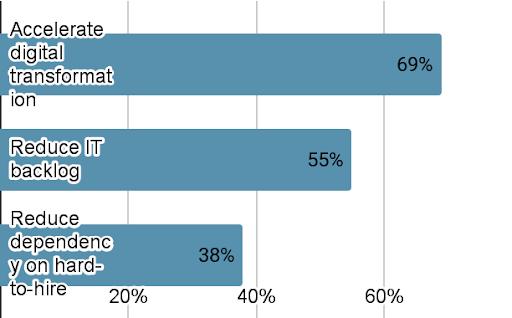
3 minute read
Low-Code Is Transforming the Software Industry: Parangat Technologies
The world is yet on the verge of the most significant technological revolution: the low-code revolutionizing. Low-Code platforms transform how software applications are built and managed, enabling companies of all sizes to quickly develop and deploy applications without extensive coding knowledge.
With this technology, businesses can save time, money, and resources while taking advantage of the latest developments in cloud computing, artificial intelligence, and machine learning.
Advertisement
This article will cover low-code platform features and how low-code platforms change the software development process. Also, this article will help you with tips on getting started with the best low-code development platforms So let’s get started.
What Does Low Code Mean?
Low code refers to a programming platform that uses graphical user interface (GUI) components and visual models instead of traditional coding languages. Low-code platforms reduce the manual coding traditionally required for developing applications, making the development process faster and simpler. Low code simplifies the development process by reducing the number of lines of code and providing developers with easy access to functions they need without having to write them from scratch.
Low-code technology has been increasing across numerous industries and businesses, providing a costeffective solution to quickly develop applications without having to write extensive code. Here is a statistics of low code usage by the top 10 industries.
Advantages of Low-Code
Low-code platforms provide businesses various advantages, from business agility to ease of deployment and improved user experience. Let’s talk about some benefits of using low code.
Business Agility
Your systems can quickly satisfy any criteria with the quick application development tool. Businesses can utilize machine learning and process automation to their maximum capacity in business process management by adopting low-code app builders.
Increased Productivity
Most low-code app development tools are template-based, allowing you to begin a project with tested templates. Program logic testing, typically necessary while designing applications, is no longer required. Additionally, since all changes are made through a graphical user interface instead of programming code, everyone on the team can contribute regardless of their level of coding knowledge.
Democratize App Development
The majority of business users have little to no programming experience. Low-code automation platforms assist in developing applications since they provide basic, user-friendly built-in features. It means organizations can get their products out on the market more quickly – allowing them to gain valuable insights from real-world usage data much sooner than if they had gone through the lengthy processes of setting up traditional software architecture.
Ease of Deployment
If you employ low code, all the modifications may be reversed with a simple click and restored to a stable version. This will solve any problems the program had in the past. Here is a statistic on why low code is such a significant need.

Low-Code Platforms Features
Thus, low-code platforms are intended to increase the software development process’s agility, usability, and scalability. But how are they able to reduce a process that is often complicated? The low code platform aspects that form the basis of this method of software development are listed below:
Visual Modeling tools
No matter the level of technical experience, anyone can perceive any information provided in a way assisted by the built-in features of the low code Even while enabling anyone to be a developer, visual modeling techniques and approaches also considerably accelerate the development of applications especially linked to code-based creation.
Out-of-the-Box Functionality
All top low-code platforms have out-of-the-box (OOTB) capabilities that eliminate the need to create core app modules from the ground up. The platforms already have several modules for application development, including data management, sales process management, and service management needed in apps with a customer-facing focus.
Drag and Drop interfaces
The drag-and-drop feature of low code platforms, one of the essential components of optimizing the design process, is another unique feature of these technologies. These interfaces let you drag and drop various application components instead of building everything from scratch. Experienced developers can equally learn from drag-and-drop tools, along with amateur developers who use them for their tasks.
Reusability
The functionalities, components, and pre-configured units alongside low code development platforms’ out-ofthe-box aspects can be used frequently for various applications. For example, the pre-configured units offer a few crucial characteristics utilized by numerous applications. These can be applied wherever required, quickening the creation of applications. One of the core principles of this development method is reuse, and low code would lose its meaning without it.
Security
Regardless of how user-friendly a low-code tool may be, it can only be regarded as a suitable solution for application development with adequate security measures. The low code platform’s apps are always safe and secure thanks to the proper security protocols that are in place. Security features are also essential to the platform’s overall security at the same time.
Cross-PlatformAccessibility
Multi-device support is a feature of a strong low-code platform. With the help of this capability, any device running one of the central operating systems can access the low-code software platform. Additionally, it assists in developing apps that work on various popular platforms and devices.
Lifecycle Management
The many steps of the development process, from testing deployment to debugging, are simplified and made simpler by the efficient lifecycle management of apps in low-code tools. For improved functionality and lifecycle management, users can utilize this feature to retrieve all the information related to a program and its development process and go back to a previous version if necessary.



